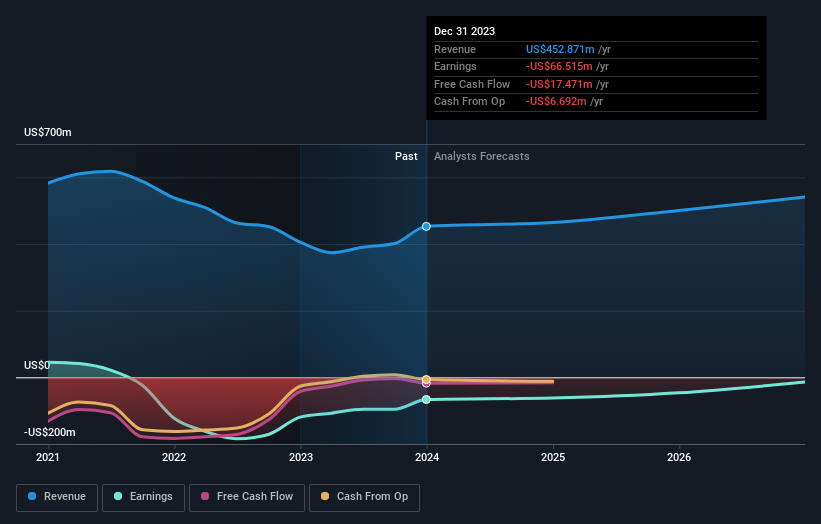eHealth, Inc. (NASDAQ:EHTH) Just Reported, And Analysts Assigned A US$8.36 Price Target
The yearly results for eHealth, Inc. (NASDAQ:EHTH) were released last week, making it a good time to revisit its performance. eHealth reported revenues of US$453m, in line with expectations, but it unfortunately also reported (statutory) losses of US$2.37 per share, which were slightly larger than expected. The analysts typically update their forecasts at each earnings report, and we can judge from their estimates whether their view of the company has changed or if there are any new concerns to be aware of. Readers will be glad to know we've aggregated the latest statutory forecasts to see whether the analysts have changed their mind on eHealth after the latest results.
Check out our latest analysis for eHealth
After the latest results, the four analysts covering eHealth are now predicting revenues of US$464.3m in 2024. If met, this would reflect a credible 2.5% improvement in revenue compared to the last 12 months. Losses are supposed to decline, shrinking 10% from last year to US$2.11. Before this earnings announcement, the analysts had been modelling revenues of US$459.0m and losses of US$2.28 per share in 2024. It looks like there's been a modest increase in sentiment in the recent updates, with the analysts becoming a bit more optimistic in their predictions for losses per share, even though the revenue numbers were unchanged.
Even with the lower forecast losses, the analysts lowered their valuations, with the average price target falling 8.2% to US$8.36. It looks likethe analysts have become less optimistic about the overall business. Fixating on a single price target can be unwise though, since the consensus target is effectively the average of analyst price targets. As a result, some investors like to look at the range of estimates to see if there are any diverging opinions on the company's valuation. The most optimistic eHealth analyst has a price target of US$13.00 per share, while the most pessimistic values it at US$5.00. Note the wide gap in analyst price targets? This implies to us that there is a fairly broad range of possible scenarios for the underlying business.
These estimates are interesting, but it can be useful to paint some more broad strokes when seeing how forecasts compare, both to the eHealth's past performance and to peers in the same industry. We can infer from the latest estimates that forecasts expect a continuation of eHealth'shistorical trends, as the 2.5% annualised revenue growth to the end of 2024 is roughly in line with the 2.4% annual growth over the past five years. By contrast, our data suggests that other companies (with analyst coverage) in a similar industry are forecast to see their revenues grow 5.9% per year. So although eHealth is expected to maintain its revenue growth rate, it's forecast to grow slower than the wider industry.
The Bottom Line
The most obvious conclusion is that the analysts made no changes to their forecasts for a loss next year. Fortunately, the analysts also reconfirmed their revenue estimates, suggesting that it's tracking in line with expectations. Although our data does suggest that eHealth's revenue is expected to perform worse than the wider industry. The consensus price target fell measurably, with the analysts seemingly not reassured by the latest results, leading to a lower estimate of eHealth's future valuation.
Following on from that line of thought, we think that the long-term prospects of the business are much more relevant than next year's earnings. We have forecasts for eHealth going out to 2026, and you can see them free on our platform here.
Before you take the next step you should know about the 3 warning signs for eHealth that we have uncovered.
Have feedback on this article? Concerned about the content? Get in touch with us directly. Alternatively, email editorial-team (at) simplywallst.com.
This article by Simply Wall St is general in nature. We provide commentary based on historical data and analyst forecasts only using an unbiased methodology and our articles are not intended to be financial advice. It does not constitute a recommendation to buy or sell any stock, and does not take account of your objectives, or your financial situation. We aim to bring you long-term focused analysis driven by fundamental data. Note that our analysis may not factor in the latest price-sensitive company announcements or qualitative material. Simply Wall St has no position in any stocks mentioned.

